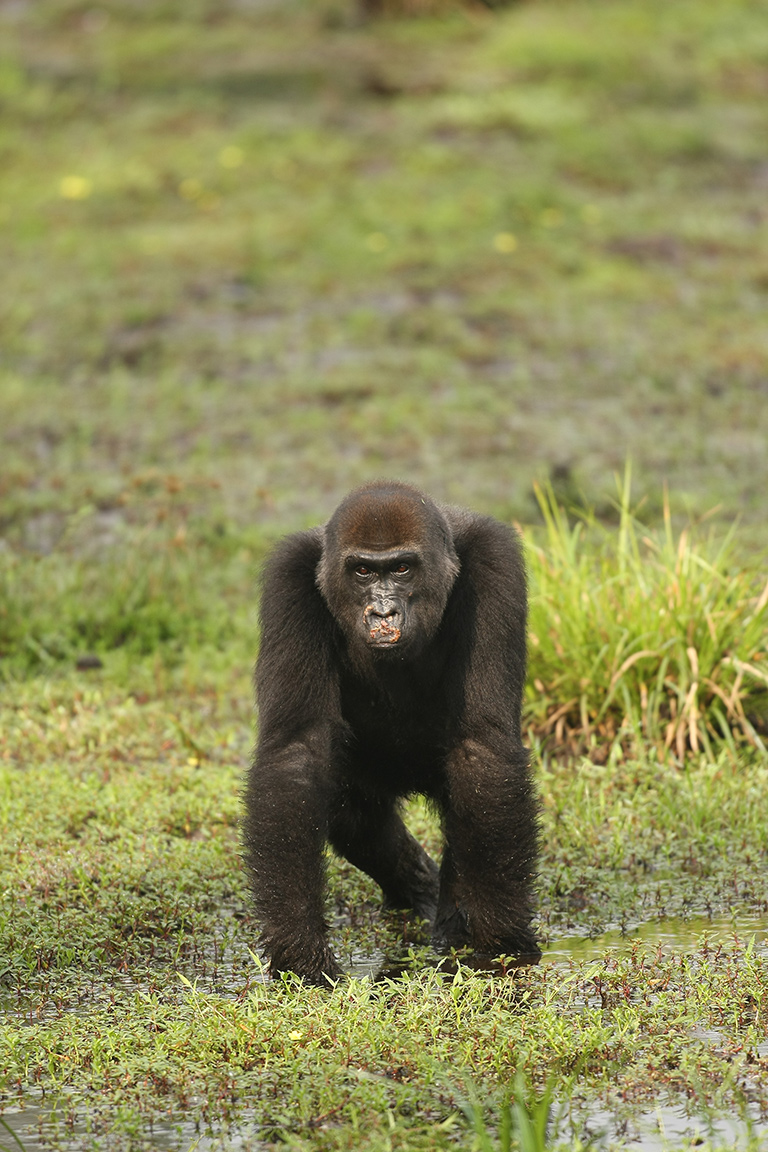- An infectious skin disease causing bright red facial lesions affects how female gorillas decide to change social groups, researchers have shown.
- Decade-long observations of nearly 600 gorillas in the Republic of the Congo revealed females are more likely to leave groups with severely diseased females or an infected silverback male.
- By reducing contact with sick individuals, females can decrease the risk of being contaminated and prevent further spread of the infection in the population.
Salt clearings deep in the Congo basin host numerous breeding groups of Western lowland gorillas (Gorilla gorilla gorilla). These intelligent social mammals usually reside in groups of two to eight females defended by a single silverback male. Now, long-term studies of these populations show that female gorillas can identify a disfiguring disease in one another, and they consciously avoid it through informed social dispersal to other groups.
A team led by Nelly Ménard of the ECOBIO laboratory at CNRS/University of Rennes 1 used a decade of observations to conclude that gorillas recognize a contagious skin infection called yaws in other individuals. Female members of a breeding group take the disease into account when deciding whether to migrate to another group.
The findings, published recently in Ecology, suggest that females are more likely to change groups when the red facial lesions caused by yaws are visible either in the silverback or among multiple females in their breeding group. They also avoid joining groups with a high prevalence of the disease.

When Ménard first visited the Odzala-Kokoua National Park in the Republic of the Congo nearly 20 years ago, she recognized that the frequent visits by gorilla social groups provided access to exceptional data on the demographic structure of their populations – as well as their dispersal patterns. During their years in the field, her team identified 593 individuals, divided into 59 breeding groups and 50 unmated units, clustered within two distinct populations of gorillas.
Females move between breeding groups several times during their lifespan. The researchers recorded dozens of instances when females left their own groups or joined new ones. Both of the studied populations live in the same dense tropical forest with overlapping home ranges, so habitat was not a factor in the females’ decisions to change groups. In all cases where both the old and new groups were known, females moved to new groups with fewer numbers of severely infected gorillas.
A female was more likely to leave her breeding group when there were more severely diseased individuals, when her breeding group was older, or when the male silverback was infected, the team’s observations showed.
“We suspected that females were able to take the disease risk into account in their decision to leave or to join a group,” said Ménard. These perceptive apes most likely associate the visual cues of red facial lesions with the worsening effects of the disease, like deformities and handicaps, she said.


Other studies have shown that spiny lobster, ants, mosquitofish, and house mice avoid others of their species who are visibly sick, said Dieter Lukas, a senior researcher at the Max Planck Institute for Evolutionary Biology in Plön, Germany, who was not involved in the study. Among primates, mandrills (Mandrillus sphinx) will avoid grooming others who are infected with endoparasites. However, the finding by Ménard’s team appears to be the first case of social mammals “choosing which group to join according to the disease status of the other group members,” Lukas said.
There is still a social toll when females leave familiar breeding groups, such as lower status in new groups or delayed mating opportunities. Females also hesitate to migrate if they have an unweaned infant, fearing infanticide. The animals weigh these risks, Lukas noted: “The interesting observation is that female gorillas might be willing to pay a short-term cost… in order to potentially avoid a long-term cost associated with contracting a disease.”
Ménard is curious whether other primates, such as chimpanzees (Pan troglodytes), show similar behaviors. “The few [chimpanzees] who visited the study clearings did not show any signs of this disease,” she said. However, a chimpanzee population being studied in Uganda displays facial deformities due to ingesting pesticides, offering a research opportunity: “It would be very interesting to test whether these [deformities] impact social relationships.”

Citation:
Baudouin, A., Gatti, S., Levréro, F., Genton, C., Cristescu, R. H., Billy, V., … Ménard, N. (2019). Disease avoidance, and breeding group age and size condition the dispersal patterns of western lowland gorilla females. Ecology, 100(9). https://doi.org/10.1002/ecy.2786
Lara Streiff (@LaraGStreiff) is a graduate student in the Science Communication Program at the University of California, Santa Cruz. Other Mongabay stories produced by UCSC students can be found at news.mongabay.com/list/ucsc.
